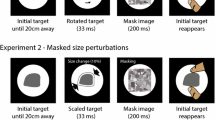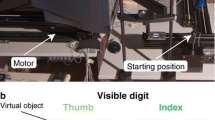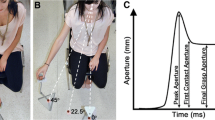Abstract
This study assessed the reach to grasp movement and its adaptive response to a simultaneous perturbation of object location and size. The aim was to clarify the means by which integration between the neural pathways modulating transport and manipulation is achieved. Participants (n = 11) were required to reach 30 cm to grasp a central illuminated cylinder of either small (0.7 cm) or large (8 cm) diameter. For a small percentage of trials (20/100) a visual perturbation was introduced unexpectedly at the onset of the reaching action. This consisted of a shift of illumination from the central cylinder to a cylinder of differing diameter (large in session A; small in session B) that was positioned 20° to the left (n = 10 trials) or to the right (n = 10) of the central cylinder. The subject was required to grasp the newly illuminated cylinder. Movement duration for these “double” (position and size) perturbed trials was much longer than those of control trials to the central cylinder (session A: by an average of 250 ms; session B: 180 ms), and the increased values were much greater than those reported previously in “single” perturbation studies where either size or location of the object was perturbed. Initial signs of a response to the “double” perturbation were seen almost simultaneously in the transport parameter of peak arm deceleration and in the manipulation parameter of maximum grip aperture, but these changes were not evident until more than 400 ms after movement onset, a response onset much later than that found in “single” perturbation studies. It is proposed that the visual change resultant from the double perturbation activates integration centres that at first gate the flow of information to the parallel channels of transport and manipulation. Following processing of this information, these centres act to instigate a synchronised and coordinated response in both components. These results add support to the existence of neural centres dedicated to the integration of parallel neural pathways, and which exercise flexibility in the degree to which these components are “coupled” functionally.
Similar content being viewed by others
Author information
Authors and Affiliations
Additional information
Received: 3 March 1997 / Accepted: 4 October 1997
Rights and permissions
About this article
Cite this article
Castiello, U., Bennett, K. & Chambers, H. Reach to grasp: the response to a simultaneous perturbation of object position and size. Exp Brain Res 120, 31–40 (1998). https://doi.org/10.1007/s002210050375
Issue Date:
DOI: https://doi.org/10.1007/s002210050375




